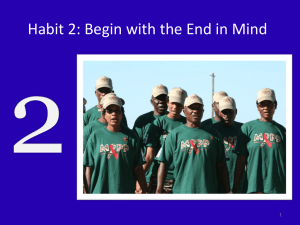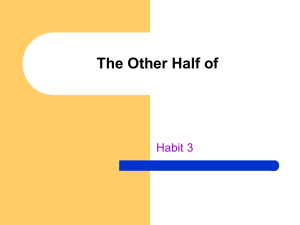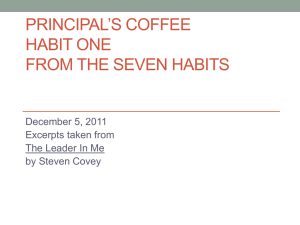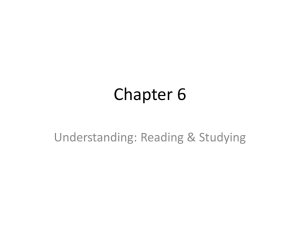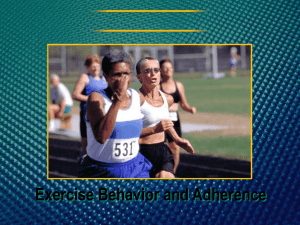Making Physical Activity a Habit
advertisement
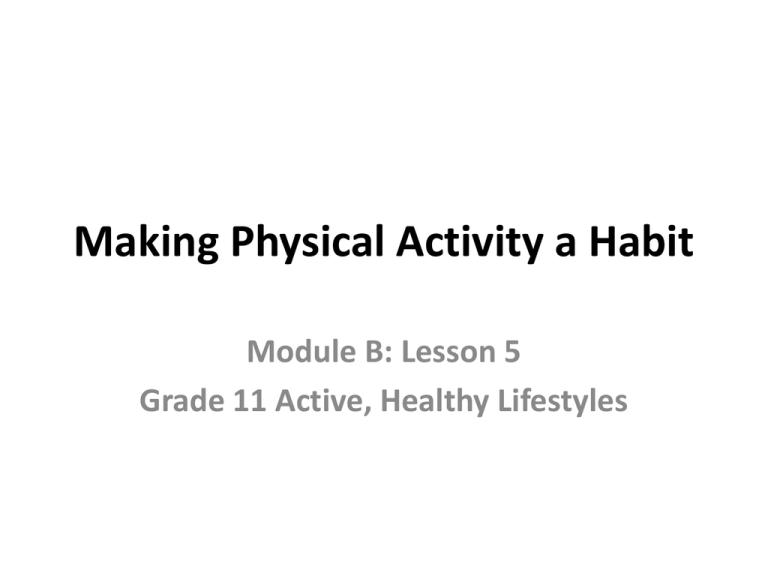
Making Physical Activity a Habit Module B: Lesson 5 Grade 11 Active, Healthy Lifestyles Edward Stanley, Earl of Derby, 1873 • “Those who think they have not time for bodily exercise will sooner or later have to find time for illness.” Getting Beyond Just Getting Started • This course is intended to: – Help you take greater ownership of your own physical fitness – Promote the discovery of physical activities suited to your interests – Encourage you to engage in active lifestyles that persist into your futures Forming a Habit • Habit formation depends on – Time – Repetition • First step to forming a new habit may be difficult but following steps can be relatively easy • All habits take time to develop – Take things slowly – Take on what you can handle Being Physically Active Is a Habit • Interests should guide activity experiences • Make it a regular occurrence in a realistic manner • Start gradually and ease into activities • Explore new activities • Do not give up on an activity program because you do not see results! – Be patient and trust that changes are happening Being Physically Active Is a Habit • Take on realistic performance goals • Measure or log performance • Incorporate physical activity strategies into daily life • Not an exercise program but every little bit helps • Variety is the spice of life • In the beginning start small and once feel comfortable consider other activities • Gradual beginnings and small incremental increases in duration or intensity, will lead to positive results • Once activities become a habit, you will not want to miss workouts New Physical Activity Habit • Track your progress in forming new physical activity habits Commitment and Exercise Adherence • Know exercise is good for us, yet a high percentage of the people who begin exercise programs drop out within the first six months. – Lack of time, inconvenience, expense, physical discomfort, embarrassment, poor instruction, inadequate support, and loss of interest • Factors that affect exercise adherence and motivation – Situation factors – Personal factors Situation Factors Affecting Exercise Adherence • To maximize exercise commitment: – – – – – – – – – Time Money Energy Other commitments Social support Exercising with others Facilities Climate Physical discomfort Time • Allow for other factors before and after the workout • Don’t ‘squeeze’ it in • Get support from friends and family • Work with an exercise partner • Plan an exercise time to avoid conflicts • Get into a weekly exercise routine • Keep in mind that “blips” in the routine can happen and these are not failures Money • Align with personal income and budget – Do not have to join or enrol – Many activities cost little or no money – Instruction can be obtained from a physical education teacher, books, videos or DVDs • Many affordable public sports facilities and community clubs Energy • Lack of energy is a common excuse for not exercising • Ironic = you actually feel energized by working out • Doing something is always better than doing nothing. • Have more energy at certain times of the day than at others - schedule workouts at these times • Nutrition or healthy eating • Rest, recovery and sleep Other Commitments • Responsibilities and commitments • Scheduling and prioritizing our commitments is essential • Incorporating exercise into other commitments • Identify where our priorities lie and be prepared to make sacrifices • “What is your health worth?” Social Support • Family and friends • Help them understand how important this is Exercising with Others • Exercising with a group or a partner – More likely to keep than to neglect commitment • Part of a team or a group exercise class – Miss a practice or class, generally have to explain absence to others • BUT fear of missing an obligation itself is not a good motivator alone to continue with exercise • Once one session is missed, it may establish a sense of failure Facilities • Affordability and location – Easily accessible location close to home, school, and/or the workplace • Comfort with surroundings is vital – Understand how to use the facilities – Know where everything is located – Know where to get assistance • Facility staff friendly, approachable and sensitive to needs Climate • Outdoor exercises • Alternate plan in the event of bad weather • Can make some facilities unusable – Safety – Allergies, asthma, common colds and respiratory infections • Manitoba’s climate provides opportunities for a tremendous variety • Planning for a change in seasons is a critical component of a successful personal activity plan Physical Discomfort • Not everyone enjoys intense physical activity or finds it easy – Significant health and fitness benefits from activities of low intensity – Expect to experience discomfort with vigorous exercise (gain significant benefits from exercising at this level) • Distinguish between pain and discomfort • To minimize discomfort with exercise: • Stay active to minimize “delayed onset muscle soreness” • Include warm-up and cool-down • Start off slowly and gradually make increases in frequency, intensity and time • Expect to sweat and breathe harder when increasing work intensity Personal Factors Affecting Exercise Adherence and Motivation • By understanding more about ourselves, we can more successfully handle the inevitable difficult situations when they arise – Awareness of personality – Goal setting Awareness of Personality • • Personality is a combination of a person’s body, thoughts and behaviours personality affects exercise adherence and motivation – Do you tend to see your exercise habit, or lack thereof, as permanent or as changeable? – Do you attribute your habit, or lack thereof, to things primarily within or outside your control? – Do you attribute your habit, or lack thereof, to internal characteristics or external circumstances? • Explaining a lack of adherence or motivation to exercise as – Permanent and beyond our control diminishes our expectations – Changeable and within our control provides a sense of empowerment, increasing the expectation of success • • Analyzing expectations can reveal something about personalities. Factors that improve self-confidence with regard to an exercise program: – – – – Prior successes and achievements Role models and success stories Verbal encouragement and persuasion Awareness and control of emotional responses to exercise Goal Setting • Enhance motivation and improve the likelihood of developing the habit • SMART Goals – Specific: What kind of exercise will you do? When will you do it? – Measurable: How many minutes? What is your target heart rate? – Attainable: Are your body and mind ready for and capable of these challenges? – Realistic: Have you created a schedule that works for you and that you can stick to? – Time framed: What will you do each week? each month? How long are you giving yourself to reach your goal? • Write your SMART Goals down in an exercise contract or memorize them and remind yourself of them daily • Rewards Reflecting on Personal Exercise Habits • What are the key factors that have allowed you to stay with an exercise program or a new physical activity plan? • Do you know of others who have successfully added the habit of exercise to their lives? How do they maintain the activity? • Are there others who can give you support and encouragement? Who could aid you in maintaining activity? How could these people help? • Are you aware of your emotions related to physical activity or exercise? Do you feel worried or confidently under control, anxious or relaxed, excited or bored? Time to Get Moving • Time to make a commitment to a personal physical activity plan Personal Physical Activity Plan/Contract • Review SMART Goals • Establish your personal physical activity goals for periodic review and amendment

